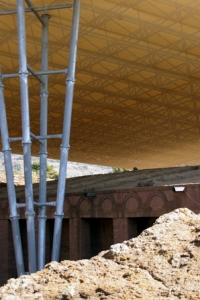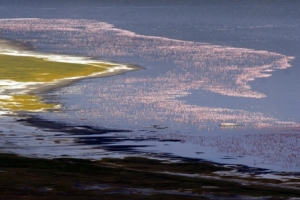An article was published recently in Nairobi which argued for a program to increase the population of lesser flamingoes in Kenya to 70,000, approximately the number that were in the country in the year 1970. The article did not say why 1970 is such a magically important year in the ecology of the lesser flamingo, nor did it say why it is we should want the number of lesser flamingoes to be forever fixed to the number of them that existed at that time. Presumably Kenya’s population of lesser flamingoes has increased and decreased over a much longer span of time than humans have been keeping censuses. Just because we started tabulating animal populations in the twentieth century does not mean that there is anything correct or natural about the figures we found. It is even possible that the contrary is true.
John Reader, in his massive book Africa: Biography of a Continent, describes the effects of a renderpest plague that virtually annihilated domestic cattle herds across Africa in the late nineteenth century. Human populations thinned and retreated from grazing land which they had inhabited for centuries.
The overall effect of the rinderpest plague…was to shift the ecological balance…heavily in favor of wild animal populations. In East Africa in particular, areas which had once supported large and relatively prosperous populations of herders and farmers were transformed into tsetse infested bush and woodlands, inhabited only by wild animals. Influential conservationists during the colonial period assumed that these regions were precious examples of African environments which had existed since time began. Believing that the plains and woodlands packed with animals were a manifestation of “natural” perfection, untouched by humanity, they declared that they should be preserved from human depredation for evermore. Most are now tsetse infested game parks: Serengeti, Masai Mara, Tsavo, Selous, Ruaha, Luangwe, Kafue, Wankie, Okavango, Kruger…
It is frightening to think that perhaps the advocate for the flamingo project – who undoubtedly considers himself to be an environmentalist or conservationist or at the very least a naturalist – believes that the populations of all animals should be frozen at the relative numbers or ratios which existed at some singular moment in the past. This would not be the protection of nature; it would be the ultimate denial of nature. It would be inorganic and therefore, by definition, unnatural.
Our desire to enforce a static planet does not apply only to natural evolution. Lalibela is an ancient and awesome complex of churches in Ethiopia. Remarkably, they were not carved in to but entirely out of the rocky hills. A bare patch on the face of a mountain was whittled away slowly and deliberately over the course of generations until only an intricately carved church remained. There are dozens of them, some no bigger than a trailer home but others the size of a brownstone. They have windows, doorways, passageways, interior rooms and niches. They are fully functional buildings of solid rock, and they have been for a thousand years.
 Recently, the government of Ethiopia and the United Nations teamed to build roofs over each of the churches. Metal scaffolding now supports sterile tarp coverings above each of the ancient monolithic structures. The emergency action was taken to protect the churches from rain damage and consequent water erosion, as though in the millennium that the churches have existed it is only recently that it has started to rain on them. As with the flamingoes, the conceit can undoubtedly be found in our relatively recent ability to measure the pace of the rock’s erosion. Sometime not too long ago, probably in the past couple of decades, a team of scientists determined that the type of rock from which the churches were freed erodes at a rate of so many millimeters per unit of time. Shortly thereafter, a team of excitable historians or archaeologists or cultural mystics of the sort who make pilgrimages to Machu Picchu on the winter solstice while reading The Celestine Prophecy fretted and guffawed loudly enough and strategically enough to get a grant to build several protective eyesores over and around the beautiful churches of Lalibela.
Recently, the government of Ethiopia and the United Nations teamed to build roofs over each of the churches. Metal scaffolding now supports sterile tarp coverings above each of the ancient monolithic structures. The emergency action was taken to protect the churches from rain damage and consequent water erosion, as though in the millennium that the churches have existed it is only recently that it has started to rain on them. As with the flamingoes, the conceit can undoubtedly be found in our relatively recent ability to measure the pace of the rock’s erosion. Sometime not too long ago, probably in the past couple of decades, a team of scientists determined that the type of rock from which the churches were freed erodes at a rate of so many millimeters per unit of time. Shortly thereafter, a team of excitable historians or archaeologists or cultural mystics of the sort who make pilgrimages to Machu Picchu on the winter solstice while reading The Celestine Prophecy fretted and guffawed loudly enough and strategically enough to get a grant to build several protective eyesores over and around the beautiful churches of Lalibela.
It has been one thousand years since the churches were carved to life. They are certainly eroding, but it is just as certain that they are not eroding very quickly. They are carved out of a mountain which, by its nature, erodes at the incomprehensibly slow pace of geology and plate tectonics. The churches of Lalibela will exist for eons and epochs, most likely outlasting the human species now in such a moralistic rush to protect them.
 In our vanity and nearsightedness, we like to believe that we are living a special moment in the evolution of the planet. During the twentieth century, technological and methodological advances allowed us to measure the previously unmeasurable. Ironically, even though many of our most exciting scientific discoveries have been about how the world changes over time, we tend to assume that the earth how we first observe it is the earth how it is supposed to be. In our rush to protect what we find, as we find it, we are stifling the evolution of the planet, the very stuff of life. The world is meant to change, flamingoes and Lalibela included.
In our vanity and nearsightedness, we like to believe that we are living a special moment in the evolution of the planet. During the twentieth century, technological and methodological advances allowed us to measure the previously unmeasurable. Ironically, even though many of our most exciting scientific discoveries have been about how the world changes over time, we tend to assume that the earth how we first observe it is the earth how it is supposed to be. In our rush to protect what we find, as we find it, we are stifling the evolution of the planet, the very stuff of life. The world is meant to change, flamingoes and Lalibela included.
